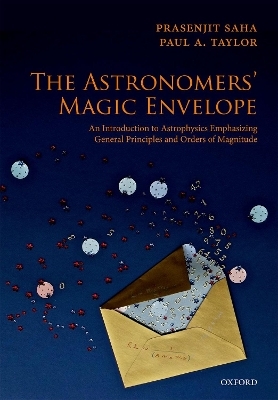
The Astronomers' Magic Envelope
Oxford University Press (Verlag)
978-0-19-881647-8 (ISBN)
Working physicists, and especially astrophysicists, value a good `back-of-the-envelope' calculation, meaning a short, elegant computation or argument that starts from general principles and leads to an interesting result. This book guides students on how to understand astrophysics using general principles and concise calculations -- endeavouring to be elegant where possible and using short computer programs where necessary.
The material proceeds in approximate historical order. The book begins with the Enlightenment-era insight that the orbits of the planets is easy, but the orbit of the Moon is a real headache, and continues to deterministic chaos. This is followed by a chapter on spacetime and black holes. Four chapters reveal how microphysics, especially quantum mechanics, allow us to understand how stars work. The last two chapters are about cosmology, bringing us to 21st-century developments on the microwave background and gravitational waves.
Prasenjit Saha is an astrophysicist working mainly on various aspects of gravitational dynamics, including gravitational lenses. He has also contributed to the literature on Bayesian inference, intensity interferometers, and literate programming. He got hooked on astrophysics from books like George Gamow's, and loves books that present a subject in an interesting and slightly subversive way. Paul A. Taylor completed his doctorate in the area of stellar astrophysics at the University of Oxford. He has subsequently been a tutor, visiting researcher and lecturer in the African Institute for Mathematical Sciences (AIMS) network in Cameroon, Ghana, Rwanda, Senegal, South Africa and Tanzania. He continues to teach programming and signal processing within the AIMS network, and is also a staff scientist in the Scientific and Statistical Computing Core at the National Institutes of Health in Bethesda, USA.
1: Orbits
2: Celestial Mechanics
3: Schwarzschild's spacetime
4: Interlude: Quantum ideal gases
5: Gravity versus pressure
6: Nuclear fusion in stars
7: The main sequence of stars
8: The expanding Universe
9: The cosmic microwave background
| Erscheinungsdatum | 31.05.2018 |
|---|---|
| Zusatzinfo | 14 line figures |
| Verlagsort | Oxford |
| Sprache | englisch |
| Maße | 172 x 247 mm |
| Gewicht | 290 g |
| Themenwelt | Naturwissenschaften ► Physik / Astronomie ► Astronomie / Astrophysik |
| ISBN-10 | 0-19-881647-2 / 0198816472 |
| ISBN-13 | 978-0-19-881647-8 / 9780198816478 |
| Zustand | Neuware |
| Haben Sie eine Frage zum Produkt? |
aus dem Bereich


